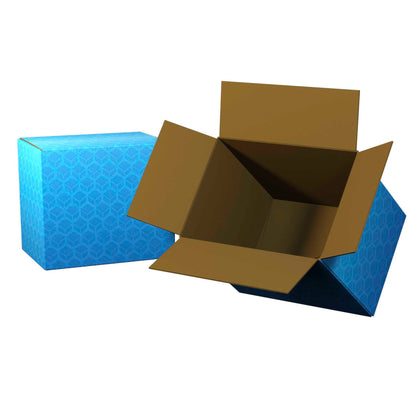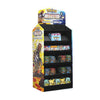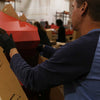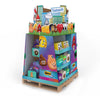

Table Of Contents
Let’s start by defining sustainability and what makes a packaging material sustainable. Sustainability is essentially a natural, all-encompassing process or system that can function by providing what is needed to be self-sufficient.
The corrugated industry has built a smooth process that is supportive, both economically and environmentally.
What Makes Corrugated So Sustainable?
Corrugated fiberboard is a sustainable material that is used in manufacturing shipping and packaging boxes. In this post, we’ll cover six reasons why corrugated material is the most sustainable packaging material, and how it can work with your product.
1) Economic Focus
Corrugated is a cost-effective packaging solution that is still reliable enough to ensure your product is safe. This lightweight packaging can be custom designed to fit a product securely while minimizing excess material waste. Since the material is entirely self-sufficient, material costs themselves will also remain low.
The responsible choice for packaging at any size, this material is sturdy but lightweight. Corrugated material lowers freight and handling costs to minimize costs with both shipping and fuel usage.
2) Reduced Waste
Corrugated packaging is easily customizable to eliminate excess material waste. This material doesn’t just minimize waste upfront; it also reduces the material being wasted after usage by being entirely recyclable. The entire container can be easily broken down and either reused or recycled.
While it minimizes the amount of material used, corrugated packaging is also entirely reusable. This material is designed to be easily collapsible and reusable for multiple purposes. Further reducing packaging costs and the environmental impact that this packaging material has.
Corrugated material is economical, sustainable, and environmentally-friendly, which is why it’s ideal for packaging.
3) Packaging is Secure
Corrugated is created using fluting with one or two sheets of linerboard, which produces a sturdy and durable material that keeps contents safe and secure. There are many different types of corrugated material that provide various levels of protection based on product and shipping type.
It is a flexible material that can be maneuvered to fit a product snugly, efficiently minimizing excess space within the packaging to ensure your product does not shift or break during shipping. This material is malleable but remains strong enough to protect the contents from the elements.
Corrugated packaging also keeps your product secure from harmful bacteria supported by the cleanliness of the material. While it is highly recyclable, it remains the safest option for shipping and containing produce.
4) Multi-functional
This material can serve as many different functions throughout the product’s journey, from packaging to shipping to displaying the product directly in the retail store. Corrugated can be utilized for any purpose throughout the process, making it an efficient and consistent material choice.
Even after the product’s journey, corrugated packaging can be utilized for storage purposes or safety measures. This packaging material can be used for many different purposes that make the material sustainable.
5) Recyclable
The corrugated industry has the best recycling rate of any packaging material used today. In fact, the fibers from corrugated fiberboard can be recycled up to 25 times. This means that most corrugated boxes are composed of 70% to 100% recycled materials.
Being such a highly recycled material makes corrugated the environmentally supportive option.
While corrugated is highly recyclable, it relies on people to be recycled, which could be tricky. Luckily 94% of Americans have access to recycling programs that accept corrugated material. It's also a biodegradable choice that will naturally absorb into the environment, further supporting a healthy ecosystem.
6) Renewable
Composed mostly of trees and recycled material, this packaging type is renewable and self-sufficient. Being manufactured primarily from renewable forests allows this industry to rely on itself entirely. This packaging can also be created from woodchips and leftover materials from a wide range of paper-making processes.
Manufacturers in the corrugated industry are working hard every day to ensure corrugated is the most sustainable packaging material offered to the market. Bennett’s commitment to sustainability is rooted in the very fibers of our products.
Learn more about what Bennett is doing to remain sustainable with our eco-friendly facility.
Related: 5 Benefits Of Packaging Manufacturers.
The flexibility and sustainability of corrugated packaging ensures it will be around for a while.
Bennett Offers Custom Packaging
Bennett is a premier packaging and retail displays manufacturing company striving to protect and promote our clients' products with customized corrugated solutions. With our fully-integrated design-to-delivery process, we can be the single supplier source.
We are an award-winning manufacturer of virtually anything corrugate. We offer everything from plain brown shipping boxes to sophisticated, high-graphic printed point-of-purchase displays, and everything in between.
Frequently Asked Questions
What Is Corrugated Cardboard?
Corrugated cardboard is made up of "corrugated paperboard", which contains rows of open-air columns inside the walls of the two or more layers. The open-air columns are what make the paper stronger than average cardboard, with the air acting as a cushion for any items inside of them. The ridges inside the wall offer strength and flexibility, which is usually needed in packaging.
What Does Corrugation Mean?
In cardboard packaging, corrugation is the process of combining layers of paper to create a structure that is strong enough for safe shipping / handling. A middle layer of paper is steamed, and pressed into a "wavy" shape to create columns of air in between the outer layers. This creates a "flute". Then all three layers are combined to create the shape of the box.




